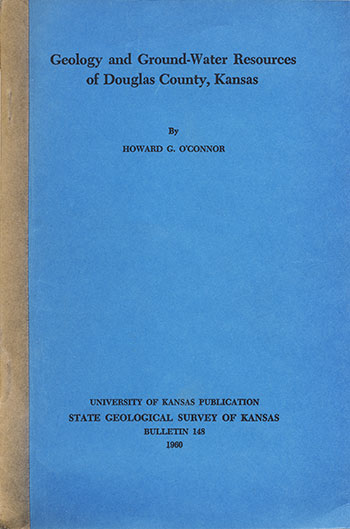Geology and Ground-water Resources of Douglas County, Kansas
by Howard G. O'Connor

Originally published in 1960 as Kansas Geological Survey Bulletin 148. This is, in general, the original text as published. The information has not been updated. An Acrobat PDF version (20 MB) is also available; plates available separately.
You may also wish to visit our web site on the Douglas County geologic map.
Abstract
This report describes the geography, geology, and ground-water resources of Douglas County, Kansas, which has an area of about 474 square miles and in 1955 had a Population of 32,067. The area lies within the Dissected Till Plain and the Osage Plain sections of the Central Lowlands physiographic province. Kansas River drains the northern three fourths, and tributaries of Marais des Cygnes River drain the southern fourth. The mean annual precipitation at Lawrence is 34.57 inches and the mean annual temperature 56.5° F. Farming, chemical manufacturing, and educational institutions employ many residents of the area. Oil and gas, sand, gravel, and limestone are mineral resources currently being produced.
In Douglas County the rocks above the Precambrian basement are 2,400 to 3,000 feet thick and are all of sedimentary origin. They include rocks of Quaternary, Pennsylvanian, Mississippian, Devonian, Ordovician, and Cambrian age. The exposed Pennsylvanian and Quaternary rocks are nearly 1,000 feet thick; their distribution is shown on a geologic map. The thickness, attitude, and sequence of the rock units are shown in cross sections.
The dominant regional structure is the Prairie Plains Monocline, which is chiefly post-Permian in age and which causes the outcropping Pennsylvanian rocks to dip northwestward about 20 feet per mile. Faulting and small sharp flexures in southern Douglas County affect the Pedee, Douglas, and lower Shawnee rocks. The faults and folds arc believed to be chiefly tectonic in origin. Extensive submarine slides and differential compaction suggest that the structures are penecontemporaneous and probably are restricted to the post-Stanton rocks.
Wisconsinan and Recent alluvial deposits 45 to 90 feet thick in the Kansas River valley yield large supplies of ground water and constitute the most important aquifer in the area, as more than four-fifths of the ground water pumped comes from an area of 6 square miles in the Kansas River valley. Illinoisan fluvial deposits and Kansan glacial and fluvial deposits locally yield small to moderate ground water supplies. The Ireland Sandstone member of the Lawrence Shale and the Tonganoxie Sandstone member of the Stranger Formation are the most important bedrock aquifers; they provide water for domestic and stock requirements and small amounts for municipal water supplies.
Fresh ground water occurs locally to a depth of about 500 feet. Water from Quaternary deposits is generally good except for carbonate hardness and locally excessive iron content. The Ireland and Tonganoxie Sandstones yield calcium and magnesium bicarbonate water of good quality in water-table areas, and downdip or downgradient in the artesian areas they yield a sodium bicarbonate water, which is generally soft though high in dissolved solids.
Ground-water pumpage in 1955 was 2,266.4 million gallons, or 6,950 acre-feet, divided as follows: public supplies 1,610 acre-feet; industrial supplies 4,490 acre-feet; irrigation supplies 630 acre-feet; and other pumpage, 220 acre-feet. Industrial and irrigation use has greatly increased since 1950.
Field data upon which this report is based include records of 436 wells, test holes, and springs; logs of 196 wells and test holes; and chemical analyses of 113 water samples.
Kansas Geological Survey, Geohydrology of Douglas County
Web version Aug. 1999. Original publication date Dec. 1960.
Comments to webadmin@kgs.ku.edu
The URL for this page is http://www.kgs.ku.edu/General/Geology/Douglas/index.html